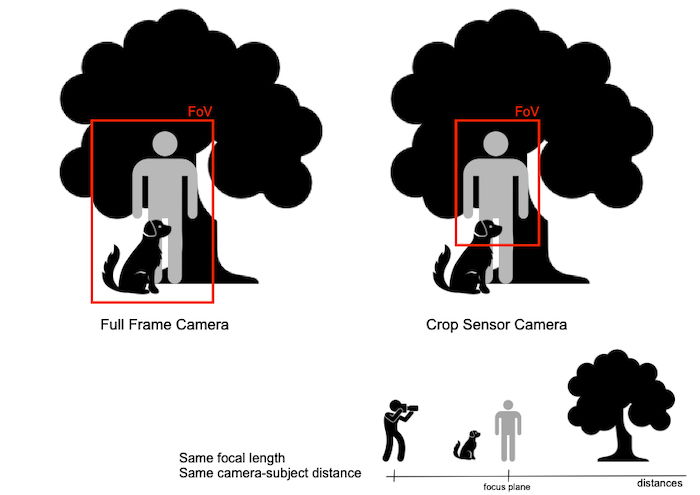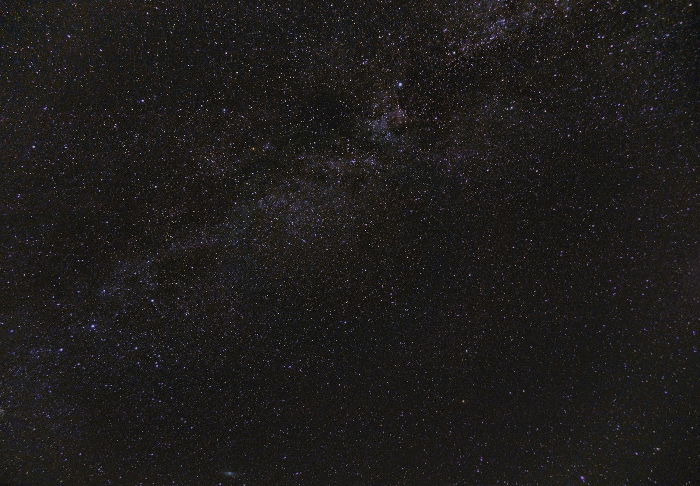There’s no one-size-fits-all answer to the question of APS-C vs full frame for astrophotography. It depends on your camera, your lens, and your shooting style. But in general, here are a few things to consider when making your decision.
Aps-C Vs Full Frame for Astrophotography: Physical Size of Common Sensor Types
Historically, the camera sensor size of reference is that of the old 35mm film.
Rather than using the sensor physical dimensions, when discussing and comparing the different sensor types a more commonly used parameter is the so called crop factor, CP, which is much easier to remember.
The CP is the ratio between the size of a full frame sensor (length and width) and that of the sensor under discussion.
Here is the crop factor for the most common sensor types:
- Full Frame: CP = 1
- Canon APS-C: CP = 1.6
- Nikon, Pentax, Sony and Sigma APS-C: CP = 1.5
- Panasonic and Olympus MFT: CP = 2
- 1″-type: CP = 2.72
- 1/3″; CP = 7.7
The scheme below allows you to visualise the meaning of the crop factor by comparing the areas of the different sensor types.

What You Need to Know About Field of View and Depth of Field
The camera sensor size, together with the lens focal length and aperture, distance to subject, etc. will affect your images in several ways, the most obvious of which is the field of view.
In order to avoid confusion when illustrating how the sensor size will affect your image, we will put ourselves in specific conditions, but in all cases we will assume that the focal length and aperture will remain the same for all cases.
Field of View
You can find a detailed discussion of depth of field and field of view here. For this article though, all you need to know is in the diagram below.

In practice, it is easier to talk in terms of equivalent focal lengths, EFL. This is the focal length needed to give the same field of view using a full frame sensor.
For example, a 50mm lens on Canon APS-C camera will give a field of view equivalent to 80 mm lens on a full frame camera.
The calculation is simple: EFL=FL*CP
In short, the smaller the sensor, the narrower the field of view is and the longer the EFL.
For more on focal length, check out this article.
You don’t have to be a math whizz to figure this out in the field. There are many online calculators you can use when planning a shoot, or smartphone apps you can use on the go.
These come in handy when creating panoramas from stitching together multiple images.
Depth of Field
Depth of Field (DoF) is related to the focus/out of focus transition in the image.
Technically, when you focus, you are focusing on a single plane. Whatever is in front of or behind said plane is out of focus.
In reality, things are a bit different. We can still see some objects that are in front or behind the subject as being ‘in focus’, even if technically they’re not.
This is because of depth of field. The DoF represents the area in your frame whose contents we perceive to be in focus.
Check out this diagram to understand how sensor size affects depth of field, when focal length, aperture and frame coverage stay unchanged. The only variable here is the sensor size.

In practice this means that with a crop sensor it can be more difficult to obtain a nice bokeh.
This is quite important in portraiture where the aim is to isolate the model from the background.
The Role of Sensor Size for Astrophotography
As mentioned many time in our astrophotography related articles, starry landscapes, star trails, planetary and deep space photography are all part of the genre. And the sensor size can impact on those kinds of photography in different ways.
The Role of Field of View in Astrophotography
Field of view is obviously as important in astrophotography as in any other kinds of photography.
If you are after starry landscapes, you may find it difficult to go wide enough to frame the entire landscape. Or to frame both the foreground and Polaris, so as to have nice circular star trails.

On MFT cameras, for example, a common focal length for wide angle lenses is 14 mm (or 12mm). This corresponds to a not very wide 28 (24) mm on full frame.
To go wider, you have to buy rather expensive zoom lenses in the 7-18 mm range. You can get a fisheye lens instead, such as the Samyang 7.5 f/3.5 fisheye lenses.
On the other hand, for planetary and deep sky photography, a cropped sensor can help to close in on your target better than with a full frame camera.
A rather inexpensive 200 mm on an MFT camera will give the same FoV of a more expensive, bulky and heavy 400 mm on a full frame camera.

The advantage in using cropped sensor camera is that you can easily close in on your target with a relatively compact and lightweight photographic system.
This will make it easier (and cheaper) to work with tracking mounts to follow star movements across the night sky.
This is perhaps the main reason why planetary cameras have small 1/3″ sensors. On my telescope with focal length 1250mm, when photographed with my MFT camera (EFL 2500mm), Jupiter is still a bright, featureless dot surrounded by four smaller dots.
These are its four largest moons, the Galilean moons: Io, Ganymede, Europa, Callisto.

In contrast, when using my ZWO ASI 224MC planetary camera with 1/3″, because of the CP=7.7, the EFL is a whopping 9625mm.
Jupiter reveals its colors, bands and the great red spot.
Depth of Field and Astrophotography
Depth of field is not something to worry about in astrophotography. The moon, planets, nebulae and stars are so far away that even if you’re shooting at f/1.2, they will be all in focus.
In practice, for example, both the Moon, 300,000km away, and Andromeda, 2.5 million light years away, will both be in focus.
The only possibility where DoF can play a role is in starry landscapes and star trails. That is, if you are very close to a foreground element.
If that is the case, you can take a photo for the foreground and then move to photograph the sky. You can combine the two images later on in Photoshop.
Pixel Size
It is often said that full frame sensors have better low light performance. This is because, usually, they have larger pixels than smaller sensors.
In practice, we can say that for a given aperture and exposure time, larger pixels will collect more photos. This means less noise, and a cleaner and more detailed image.
Pixel size is also related to the sensor dynamic range. The larger the pixels, the wider the dynamic range. You’ll be able to better record highly contrasted scenes.
In astrophotography, this is useful to retain colors in the bright stars or galaxy core, while recording the faintest details.
Image Resolution
Not to be confused with the resolution in pixels, these depend on the sensor size (or pixel size) and the focal lens used.
In astrophotography, sizes of stars, nebulae and galaxies are expressed as apparent angular size. The image resolution is expressed as arcseconds/px (also indicated as “/px). This will give you a measure of how big the portion of sky you will record on each pixel is.
In practice, the part of the sky that is recorded in a pixel will have no details in it.
The message here is that a low resolution (large “/px) will result in a smoother, but less detailed image. And a high image resolution (small “/px) will give you crispy and detailed images.
The drawback of high resolution setups is that poor seeing (i.e. poor visual conditions for the sky) will null the benefit of such high resolution. The amount of details you can see are limited by the seeing conditions.
Also, tracking errors will be much more visible in the form of elongated stars.

Best Cameras For Astrophotography
With the argument presented above in mind, we can say that the best cameras for astrophotography are:
- APS-C or FF cameras for starry landscape and star trails. It is easy to get a large enough FoV and they have somewhat better low light performances and greater dynamic range.
- For planetary work, a small sensor planetary camera allows to close in on the target thanks to the small FoV.
- Deep Sky Photography can benefit from a cropped sensor, like that in MFT cameras. It will keep your photographic setup compact and lightweight. This will allow you to use lighter (and cheaper) tracking mounts.
- On the other hand, if you photograph with a telescope, then MFT have a too narrow FoV and a full frame camera will be best.
Having said that, remember that these are very general guidelines. Any kind of modern camera will give you good results, once you understand the limitations and how to work around them.

Conclusion
This article is only the tip of the iceberg. Things such has quantum efficiency, read noise, full well, and so on, are other factors that determine the sensor’s capabilities, particularly for astrophotography.
But this a good broad discussion of how sensor size can affect your photography. And how to take advantage of various sensor sizes for better astrophotography.
Finally, remember that sensors are electronic devices. Their performance can vary dramatically with age. A full frame sensor that is a few years old might perform worse than a brand new APS-C or MFT sensor.
Want to know more about sensor size? Check out our new post about equivalence in photography next!
